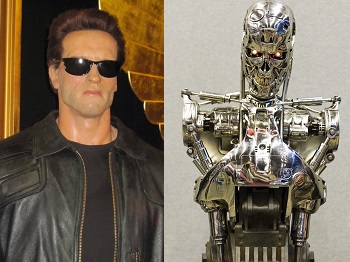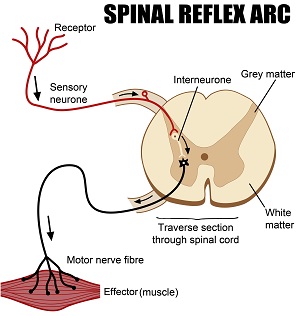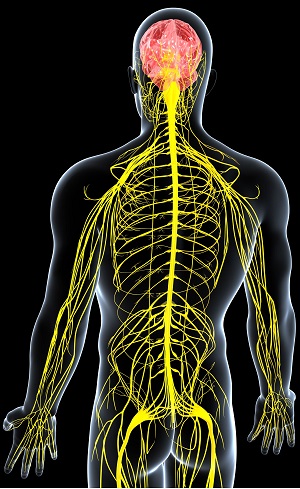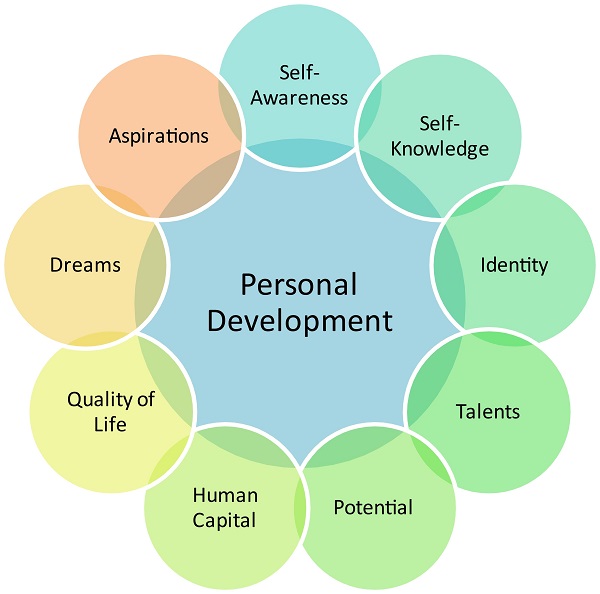08 Feb Seeing Within: Proprioception for Robots
 I saw a couple movies awhile back, “The Terminator” and “Terminator 2” in which artificial intelligence in computers became hazardous to the survival of humanity. One of the premises, as I recall, was that the critical event that lead to the disastrous attempt of man-made machines to destroy humanity, was when they became “self-aware”. This was apparently the first step in their progress toward self-determination. Is this even possible? I think it’s closer than you may think, and I don’t think it’s scary at all. Computers and mobile devices are coming out with more built-in hardware, firmware and software capabilities that approach the paradigm of self-awareness. Internal clocks tell the year, month, day, hour and second. Global Positioning tells them their exact location geo-coordinates. Self-diagnostics tell them when they are low on memory or infected by a virus. One of the biggest missing pieces is context.
I saw a couple movies awhile back, “The Terminator” and “Terminator 2” in which artificial intelligence in computers became hazardous to the survival of humanity. One of the premises, as I recall, was that the critical event that lead to the disastrous attempt of man-made machines to destroy humanity, was when they became “self-aware”. This was apparently the first step in their progress toward self-determination. Is this even possible? I think it’s closer than you may think, and I don’t think it’s scary at all. Computers and mobile devices are coming out with more built-in hardware, firmware and software capabilities that approach the paradigm of self-awareness. Internal clocks tell the year, month, day, hour and second. Global Positioning tells them their exact location geo-coordinates. Self-diagnostics tell them when they are low on memory or infected by a virus. One of the biggest missing pieces is context.
| Understanding Context Cross-Reference |
|---|
| Click on these Links to other posts and glossary/bibliography references |
|
|
|
| Prior Post | Next Post |
| Mindfulness | Conscious Sensibility |
| Definitions | References |
| understanding mind | Psychology Dictionary: Introception |
| kinesthesia proprioception | Shannon Lee: Bryn Mawr Jim Brown |
| interoception | McCloskey 1978 Sherrington 1906 |
Self-awareness seems to be built into some personal digital assistants, such as Siri on Apple iPhones. Yesterday, I posted about mindfulness and how it can serve to accelerate our intellectual development. Near the end of yesterday’s post, I even got into some value judgements about mindfulness. I found this illustration of some of the mental, emotional and aspirational elements of seeing within, or introception.
Introception
Psychology Dictionary: http://psychologydictionary.org/introception/ says “A person that is attentive and understanding to the motives, needs and experiences of herself or himself and others. It is a reflecting personality trait.
This illustration points entirely inward, while introception, by definition, also considers similar aspects of others around us. This sounds like an ability lacking in the socially awkward. Is it possible that inabilities in introception may be a symptom of some forms of autism? These elements are essential to self-realization, but they say nothing about the physical body. As I have suggested before, I think the human mind, if such a thing exists, consists not only of the brain but of the entire body. Today, I’d like to point out some human self-awareness capabilities that are extensions of our innate senses, especially the kinesthetic sense.
Reflexes
 Our reflexes are so efficient that input signals from neurons can produce reflexive muscle reactions without even consulting the brain. Interneurones in the spinal cord can relay messages to the muscles causing involuntary reactions. This illustration of the spinal reflex arc shows how simple the circuitry is. This arc circuit is repeated countless times throughout the body, and plays an important protective role as it helps minimize damage when we touch a hot surface or encounter an unseen obstacle. Receptors in the peripheral nervous system take many shapes and forms, and play multiple roles in supporting both our sense of touch and our internal sense of kinesthesia.
Our reflexes are so efficient that input signals from neurons can produce reflexive muscle reactions without even consulting the brain. Interneurones in the spinal cord can relay messages to the muscles causing involuntary reactions. This illustration of the spinal reflex arc shows how simple the circuitry is. This arc circuit is repeated countless times throughout the body, and plays an important protective role as it helps minimize damage when we touch a hot surface or encounter an unseen obstacle. Receptors in the peripheral nervous system take many shapes and forms, and play multiple roles in supporting both our sense of touch and our internal sense of kinesthesia.
Proprioception
Proprioception is about two things:
- internally using kinesthesia to know about and manage the parts of the body in relation to other parts and ones self; and
- externally using proprioceptive feedback to place ones-self in the broader universe.
On one hand, the proprioceptive response to negative stimuli and lack of coordination helps us learn what not to do. On the other, the thrill of physical victory may become addictive, driving us to do certain things more and better.
At http://www.coreperformance.com/knowledge/training/all-about-proprioception.html, the connection to the thrill of victory is clear: “Proprioception is the capacity of the body to determine where all of its parts are positioned at any given time, and it plays an important role in the world of sports.” Jim Brown goes on to say how this is important for balance: ” complements your conscious effort to stabilize everything, whether you’re moving or standing still. It triggers muscles to contract and relax to fit the situation. For example, close your eyes and balance on one foot. Notice how your leg muscles contract and relax to help you maintain balance.”
At http://serendip.brynmawr.edu/exchange/node/1699, Shannon Lee tells us that “Proprioception and kinesthesia, the sensation of joint motion and acceleration, are the sensory feedback mechanisms for motor control and posture. Theses mechanisms along with the vestibular system, a fluid filled network within the inner ear that can feel the pull of gravity and helps the body keep oriented and balanced, are unconsciously utilized by the brain to provide a constant influx of sensory information”
At https://kclpure.kcl.ac.uk/portal/en/publications/the-case-for-proprioception(6082fc40-a9bd-4955-9168-a4ae2e89dfe7)/export.html, Dr. Ellen Fridland makes a case for proprioception being treated with all due respect vis-a-vis other senses.
 At http://science1.nasa.gov/science-news/science-at-nasa/2001/ast07aug_1/, we learn about proprioception in zero gravity. We rely on proprioception to know our place in the universe: “The vestibular system isn’t the only one affected by the absence of weight. The proprioceptive system — that is, nerves in the body’s joints and muscles that tell us where our arms and legs are without having to look — can also be fooled. Without the stresses in the joints usually caused by the pull of gravity, this sense is sometimes dampened. ‘The first night in space when I was drifting off to sleep,’ recalled one Apollo astronaut, ‘I suddenly realized that I had lost track of … my arms and legs. For all my mind could tell, my limbs were not there. However, with a conscious command for an arm or leg to move, it instantly reappeared — only to disappear again when I relaxed.’ Another astronaut from the Gemini program reported waking in the dark during a mission and seeing a disembodied glow-in-the-dark watch floating in front of him. Where had it come from? He realized moments later that the watch was around his own wrist.”
At http://science1.nasa.gov/science-news/science-at-nasa/2001/ast07aug_1/, we learn about proprioception in zero gravity. We rely on proprioception to know our place in the universe: “The vestibular system isn’t the only one affected by the absence of weight. The proprioceptive system — that is, nerves in the body’s joints and muscles that tell us where our arms and legs are without having to look — can also be fooled. Without the stresses in the joints usually caused by the pull of gravity, this sense is sometimes dampened. ‘The first night in space when I was drifting off to sleep,’ recalled one Apollo astronaut, ‘I suddenly realized that I had lost track of … my arms and legs. For all my mind could tell, my limbs were not there. However, with a conscious command for an arm or leg to move, it instantly reappeared — only to disappear again when I relaxed.’ Another astronaut from the Gemini program reported waking in the dark during a mission and seeing a disembodied glow-in-the-dark watch floating in front of him. Where had it come from? He realized moments later that the watch was around his own wrist.”
At http://cirrie.buffalo.edu/encyclopedia/en/article/337/, we learn that the term proprioception is used to describe the sensory information that contributes to the sense of position of self and movement. Sir Charles Bell named the “sixth sense” as the sense of the positions and actions of the limbs (McCloskey 1978). Sherrington (1906) first used the term proprioception to define the sense of body position. Body position is perceived both at the conscious and unconscious levels.
McCloskey DI. 1978. Kinesthetic Sensibility. Physiological Reviews 58:763-811
Sherrington CS. 1906. The Integrative Action of the Nervous System. New Haven: Yale Univ Press.
Interoception
When we itch or feel pain, it is through interoception: the sense that tells us the conditions of the tissues. Proprioception is considered exteroceptive.
http://www.ncbi.nlm.nih.gov/pubmed/12965300 “Converging evidence indicates that primates have a distinct cortical image of homeostatic afferent activity that reflects all aspects of the physiological condition of all tissues of the body. This interoceptive system, associated with autonomic motor control, is distinct from the exteroceptive system (cutaneous mechanoreception and proprioception) that guides somatic motor activity. The primary interoceptive representation in the dorsal posterior insula engenders distinct highly resolved feelings from the body that include pain, temperature, itch, sensual touch, muscular and visceral sensations, vasomotor activity, hunger, thirst, and ‘air hunger’. In humans, a meta-representation of the primary interoceptive activity is engendered in the right anterior insula, which seems to provide the basis for the subjective image of the material self as a feeling (sentient) entity, that is, emotional awareness.”
I will show, especially in the later sections, how each of these human capabilities can be modeled in artificial intelligence software and systems to deliver self-aware computers that should pose no threat to humankind, but open doors to mutual understanding and greater productivity.
| Click below to look in each Understanding Context section |
|---|









